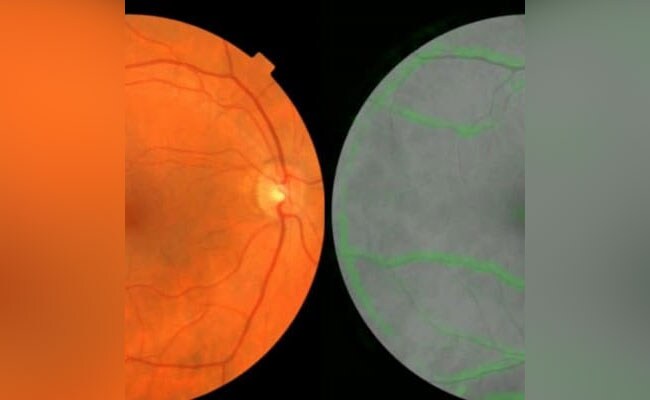The new approach could build on doctors' current abilities by providing a tool that people could one day use to quickly and easily screen themselves for health risks that can contribute to heart disease, the leading cause of death worldwide.

The green highlights are parts algorithm found most helpful in predicting blood pressure
HIGHLIGHTS
- The work needs to be validated on more people
- True power of this technology is that it could flag risk with cheap test
- However, Google's algorithms were far from perfect
By looking at the human eye, Google's algorithms were able to predict whether someone had high blood pressure or was at risk of a heart attack or stroke, Google researchers said Monday, opening a new opportunity for artificial intelligence in the vast and lucrative global health industry.
The algorithms didn't outperform existing medical approaches such as blood tests, according to a study of the finding published in the journal Nature Biomedical Engineering. The work needs to be validated and repeated on more people before it gains broader acceptance, several outside physicians said.
But the new approach could build on doctors' current abilities by providing a tool that people could one day use to quickly and easily screen themselves for health risks that can contribute to heart disease, the leading cause of death worldwide.
"This may be a rapid way for people to screen for risk," Harlan Krumholz, a cardiologist at Yale University who was not involved in the study, wrote in an email. "Diagnosis is about to get turbo-charged by technology. And one avenue is to empower people with rapid ways to get useful information about their health."
Google researchers fed images scanned from the retinas of more than 280,000 patients across the United States and United Kingdom into its intricate pattern-recognizing algorithms, known as neural networks. Those scans helped train the networks on which telltale signs tended to indicate long-term health dangers.
Medical professionals today can look for similar signs by using a device to inspect the retina, drawing the patient's blood or assessing risk factors such as their age, gender, weight and whether they smoke. But no one taught the algorithms what to look for: Instead, the systems taught themselves, by reviewing enough data to learn the patterns often found in the eyes of people at risk.
The true power of this kind of technological solution is that it could flag risk with a fast, cheap and non-invasive test that could be administered in a range of settings, letting people know if they should come in for follow-up.
The research, one of an increasing number of conceptual health-technology studies, was conducted by Google and Verily Life Sciences, a subsidiary of Google's parent Alphabet.
The idea that people's eyes might reveal signs of underlying cardiovascular disease isn't as outlandish as it might seem. Diabetes and high blood pressure, for example, can cause changes in the retina.
Krumholz cautioned that an eye scan isn't ready to replace more conventional approaches. Maulik Majmudar, associate director of the Healthcare Transformation Lab at Massachusetts General Hospital, called the model "impressive" but noted that the results show how tough it is to make significant improvements in cardiovascular risk prediction. Age and gender are powerful predictors of risk, without the need for any additional testing.
Google's algorithms approached the accuracy of current methods but were far from perfect. When presented images of the eyes of two different people - one who suffered a major adverse cardiac event such as a heart attack or stroke within five years of the photo and the other who did not - the algorithms could correctly pick the patient who fell ill 70 percent of the time.
Similar deep-learning technologies have exploded in the past five years and are widely used today in systems such as Google's image search and Facebook's facial recognition. They are also showing promise in other arenas of health, including by looking for signs of cancer in the X-ray scans reviewed by radiologists.
The Google researchers used similar machine-learning methods in 2016 to look for diabetic retinopathy, an eye disease that is a major cause of blindness. This time, they also used a machine-learning technique, known as "soft attention," to help pinpoint which parts of the image were most instrumental in driving the algorithms' prediction. One vulnerability of many neutral networks today is that it's often unclear how or why they reached that conclusion - a "black box" problem that could undermine doctors' or patients' trust in the results.
The idea that the hallmarks of disease could be detected through computational analysis has been alluring to engineers. DeepMind, the London-based AI-development firm bought by Google in 2014 that often operates autonomously, released research earlier this month showing similar algorithms could help detect signs of glaucoma and other eye diseases.
Apple late last year launched a heart study tied to its Apple Watch to see if it could detect and alert people to irregular heart rhythms that could be a sign of atrial fibrillation, a leading cause of stroke.
(This story has not been edited by NDTV staff and is auto-generated from a syndicated feed.)
DoctorNDTV is the one stop site for all your health needs providing the most credible health information, health news and tips with expert advice on healthy living, diet plans, informative videos etc. You can get the most relevant and accurate info you need about health problems like diabetes, cancer, pregnancy, HIV and AIDS, weight loss and many other lifestyle diseases. We have a panel of over 350 experts who help us develop content by giving their valuable inputs and bringing to us the latest in the world of healthcare.















